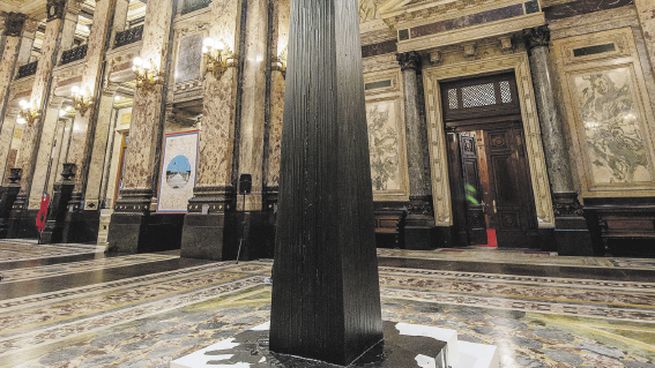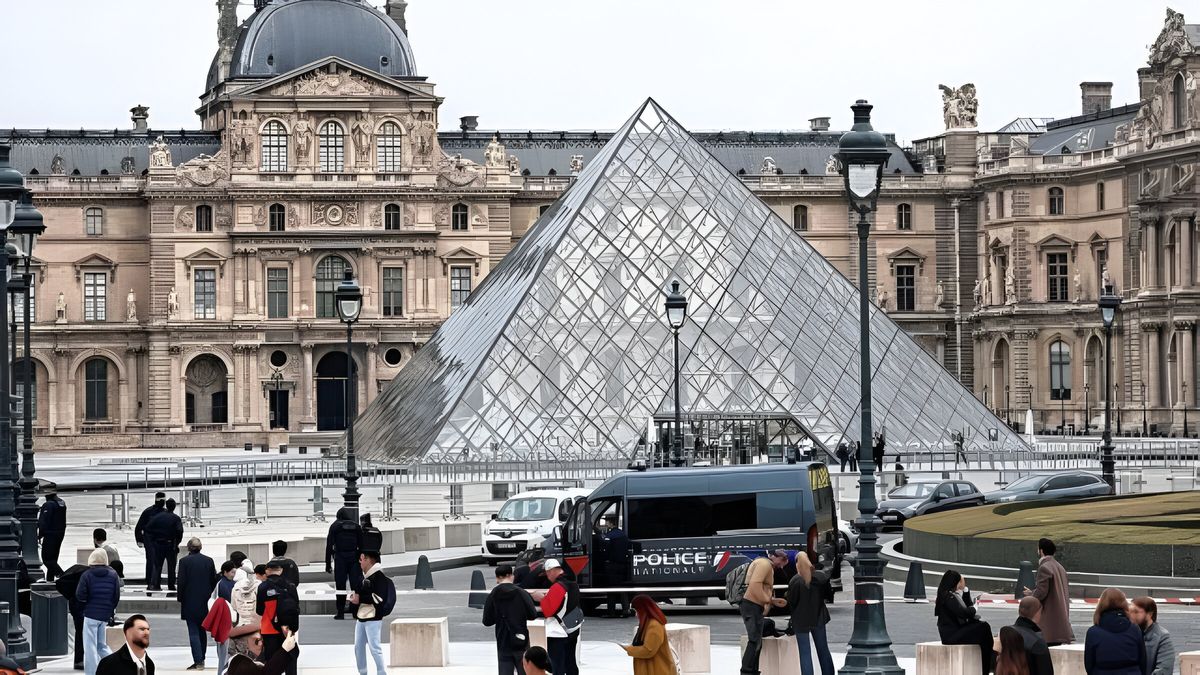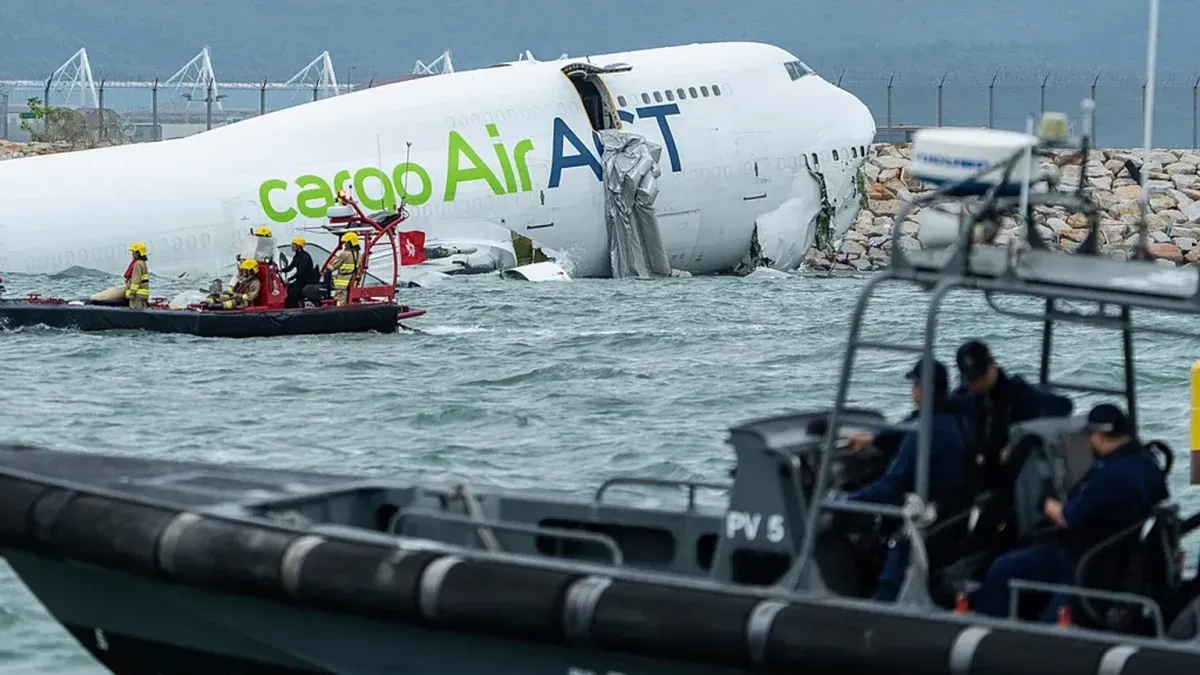The fifth edition of its Biennial, inaugurated last week curated by the German Alfons Hug, exhibited bold expressions of world art.
kadan. The kyiv artist presented his black and tarred Obelisk.
Montevideo – The fifth edition of the Montevideo Biennial opened last week in the imposing building of the Legislative Palace. The sessions were not suspended and the organizers of the Biennial, Laetitia d’Arenberg, Juan Etcheverrito, Ricardo Murara, together with the responsible curator, Alfons Hug and the cultural operator Graciela Rompani, decided, with the consent of both Chambers and the political authorities, gather in the Salón de los Pasos Perdidos until November 30, the most audacious expressions of contemporary art. The German Alfons Hug, curator of the previous biennials, presented the idea that forms the basis of the current exhibition. “The rest of the world”, a term used in economics that imposes a new geographic axis and crosses areas of the world far from cities like Berlin or New York, considered until yesterday unavoidable centers of artistic production.
The content you want to access is exclusive to subscribers.
The starting point of the Biennial is a historical event: the treaty on the distribution of lands signed in 1518 by the King of Spain and the navigator Ferdinand Magellan. The curator places emphasis on the key work of his story, “Imago Mundi,” a video installation by Malaysian artist Ahmad Fuad Osman. There he tells of Magellan’s fateful voyage from the perspective of the Malay slave Enrique de Malacca, who the navigator bought in India because he mastered more than five languages and became his translator. Osman’s work speaks of the dominance of the Iberian powers and presents Malacca as one of the few survivors of the first circumnavigation, given that after discovering the strait that bears his name, Magellan died in the Philippines. According to a prominent Venetian historian, one of Magellan’s last wishes was to grant Malacca freedom, the status of a “free man.”


In his curatorial text, Hug points out that this work is the “poetic anchor and leitmotiv of the Biennial, which examines the state of the world from a decidedly peripheral and non-hegemonic perspective. Enrique’s echo resonates in the new voices of artists from Indonesia, Kazakhstan, Georgia, Azerbaijan and Iran, juxtaposed with those of Brazil and Uruguay. Many of these artists come from conflictive regions, such as the Caucasus and the Middle East, or from Ukraine, where the greatest conflict between the periphery and the old imperial center is currently taking place. In his war diary (1917-22), the Soviet literary theorist Viktor Shklovskij predicted the coming disaster: “A black current blew from black and empty Russia, the air current of madness.”
From Kiev, Ukraine, the artist Nikita Kadan arrived with “The Black Obelisk” and tarred, a monument that stands as a demonstration of “shame”, as imposing as those destined to exalt glory. And the immense Obelisk awakens the memory of the hardships of the world, to which today is added the conflict between Israel and Palestine, in the heart of the beautiful Hall of the Lost Steps that is more than 50 meters long and 20 meters high, light overhead, stained glass and marbles of different colors. The Legislative Palace was inaugurated in 1925 and is the most distant space from the white, minimalist box conducive to exhibiting art that, in this case, adapts to architecture.
Among the columns are cartographies with both a historical and subjective character by the Uruguayan Juliana Rosales, whose research takes the format of large maps. Hug has been around the world several times and likes to highlight “I have seen biennials in port warehouses, banks, museums, hangars, airports, shipyards, an 8th century cistern in Istanbul, but this is the only one that is made in a Parliament”. Hug curated two biennials in São Paulo, the End of the World in Ushuaia and the Mercosur in Porto Alegre, in addition to the Italo-Latin American Institute at the Venice Biennale. Today he lives in Azerbaijan, a territory located between Russia, Iran and Türkiye. From there comes the film by Alexandre Michon, who in 1900 filmed an explosion of an oil well in Baku, when the height of the fuel attracted workers from all over Europe.
The care and preservation of the environment is a mandatory issue. In this exhibition, Tita Salina from Palenbang, Indonesia, presents “Isla”, a video that tells of the “plan” to build 17,000 artificial islands and “land reclaimed from the sea” in the largest archipelago in the world. Tita collected marine debris and plastic trash to build another artificial island, of a different nature. “Diógenes Syndrome” is the name of Santiago Grandal’s installation, a work that demonstrates the mania for accumulating. While he describes a pathology of older adults, his art enters the field of psychiatry. On the other hand, Alejandra González Soca represents a romantic dream in the installation “Hilo partedo”, a gigantic wedding dress made up of hundreds of dresses that the artist borrowed and that arrived accompanied by the feelings and wishes of their owners. Fabricio Guaragna is in charge of guided tours at the Museum of Visual Arts of Montevideo. But he also has an active nightlife as a Drag Queen, and with this identity he dialogues with visitors to the Biennial. The Uruguayan Gustavo Jauge presented a large wheel of empty bibliographies on the floor. The installation expresses an open criticism of the mostly useless bureaucratic efforts. The photos of Dmytro Kozatsky, a soldier who resisted in Mariupol, testify to the Ukrainian resistance to the Russian invasion. Before his capture, he managed to post photos of him on social media and asked that the images be shared and viralized as a testimony to the cruelty of war. And in this way art intersects with real life.
The outfits of Yudoyoko Yudi, from Jakarta, Indonesia, combine beauty with the explicit content that she incorporates in her clothes. The artist works on “Dress Code” with the skill and quality of a brilliant fashion designer. With her personal style she laser cuts the perfect lines of the star and Turkish crescent on a red dress. Meanwhile, also visible on a white tunic, the letters that are the emblem of the Louis Vuitton brand can be seen from afar. Yudoyoko analyzes the power of symbols of social communication through clothing.
Among other artists, Almagul Menlibayeva from Kazakhstan presents the project “AI Realism Qantar”, a series of images created with artificial intelligence with words related to the pain of the body and the collective trauma of the so-called “Bloody January” of the 2022 riots. Finally, Alfons Hug puts immeasurable human suffering before everyone’s eyes, but he asks: “What distinguishes this new art?” And he answers himself: “In addition to the originality of the themes and the language of the forms, it is probably the human factor: an attitude that reaffirms life despite all adversities.”
Source: Ambito
I am an author and journalist who has worked in the entertainment industry for over a decade. I currently work as a news editor at a major news website, and my focus is on covering the latest trends in entertainment. I also write occasional pieces for other outlets, and have authored two books about the entertainment industry.




